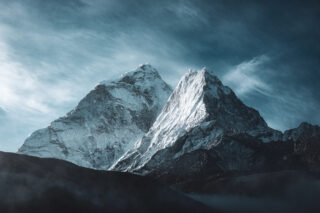
Scale Breaker Nepal
Our LHO Ama Dablam Expedition is expertly curated to offer a comprehensive Himalayan climbing experience that places safety at its absolute core. Led by our LHO Team Leader in close collaboration with our IFMGA-certified guide and local team, this expedition places a unique focus on education, ensuring that the skills and capabilities of each climber are well above the minimum requirements needed to safely ascend this great Himalayan achievement. Additionally, we are the only expedition to offer photography as a standard part of our adventure, meaning that you can fully focus on your experience.

TRIP TYPE
Climbing and Mountaineering

DURATION
25 Days

DESTINATION
Nepal
1
Guided by a specialised LHO Expedition Coordinator and senior Ama Dablam guides, ensuring a seamless, safe experience, with full support on and off the mountain.
2
Relive the adventure with exclusive expedition photography captured by your LHO Team Leader, included as part of our standard offering.
3
100% safety record, superior tea house selection, top base camp infrastructure, and an adaptable itinerary with multiple weather windows.






2026
DATE & STATUS
PRICE
TEAM LEADER
AVAILABILITY
WHAT'S INCLUDED IN THIS TRIP
WHAT'S NOT INCLUDED IN THIS TRIP
DAY 1: WELCOME TO WILD KATHMANDU
Kathmandu is an incredible, vibrant, and wild city that we’ve fallen in love with. That’s why we’re always so excited to receive you on the first day and share the gateway to the Himalayas with you.
On arrival day, you’ll be met by an LHO representative at the airport and driven to our centrally located hotel by private transfer. Navigating Kathmandu airport can be an adventure in and of itself, so you’ll receive a text with detailed instructions on how to efficiently make your way to us.
Your LHO Team Leader will be waiting to receive you at our hotel, check you in, and make sure that you have everything you need for our adventure. If you arrive early, there are loads of incredible places to visit around us. Your LHO Team Leader will send you a detailed list of restaurants, coffee shops, heritage sites, and markets to visit closer to your trip start date so that you can make the most of your time.
Our first official event of the trip is a team dinner at 7:30 pm hosted by your LHO Team Leader and local lead guide. This will be your first opportunity to meet everyone, ask any questions you have, hear all about the amazing week ahead of us, and enjoy a great meal. Although it’s difficult not to be tempted by the nearby nightlife, we recommend an early rest to recover from your travels.
DAY 2: EXPLORING THE GATEWAY TO THE HIMALAYAS
Our first full day together gives us an opportunity to discover the magical city of Kathmandu, check our gear, and get to know each other before we head out to the trail. We’ll visit the nearby sites of Durbar Square and the Monkey Temple as well as get our first taste of Nepali cuisine during our team lunch.
Due to air traffic in Kathmandu airport, the government sometimes takes the decision to assign all flights to the Everest region from an alternative airport three hours away from the city. We’ve determined that waking up exceptionally early on the day of the flight to make the land journey limits the much-needed rest before heading out on our adventure. That’s why, if flights won’t be departing from Kathmandu Airport, we will make our way to a hotel closer to our departure airport today. This gives us a chance to have a full night’s rest. Your Team Leader will inform you about the plans of the day upon your arrival in Kathmandu as this information can change regularly. Regardless, our team dinner will be at the accommodation we sleep at on the night.
DAY 3: TASHI DELEK
Distance: 8.7 KM | Ascent: 364 M | Descent: 521 M | Max Altitude: 2,860 M
Our day starts after breakfast as we make our way to the airport to board one of the most incredible flights you’ll ever take. As with all internal flights, delays are expected. Flights to Lukla are particularly notorious for never departing on time. Not to worry, though, every moment spent waiting is worth it when we get there. The flight itself takes about fifty minutes.
Once in Lukla, we’ll be met by our porter team who will collect our duffle bags and take them to a local tea house where we’ll have lunch and prepare ourselves for the trek to Phakding. Lukla is one of the most vibrant villages in the Khumbu region. It’s an important hub of local and regional commerce as well as the border to the sacred high-altitude regions. Above Lukla, animal slaughter is religiously banned. That’s why we don’t recommend choosing any meat or chicken options above Lukla.
The trail begins at the entrance of the village and is actually mostly descending in the alpine forests and through the many towns that dot this section of the trail. The Tibetan influence and Buddhist character of the area are immediately apparent in the calligraphy, architecture, and religious stupas and shrines.
Our accommodation sits just above Phakding near the Khumbu river that is formed from the melting glaciers of the towering summits of the region, including Everest. Depending on our arrival time, it may be possible to explore the coffee shops and market streets of the village before dinner.
DAY 4: NAMCHE BAZAAR
Distance: 9.1 KM | Ascent: 1,095 M | Descent: 380 M | Max Altitude: 3,440 M
Our second day on the trail will be a full-on ascent to an impressive altitude of 3,445 meters, arriving at one of the most vibrant and remote high-altitude towns on the planet: Namche Bazaar. The trail begins by following the river and passes through the alpine forests. The trail is once again dotted by a series of villages and farming communities that add an incredible element of rural life to the walk.
Our first main objective is reaching the town of Monjo. This is the official entrance to the Sagarmatha National Park. There is a brief checkpoint where we present your permits to the authorities. Once through, we’ll descend a series of staircases flanked by Tibetan calligraphy carved into the rocks. We’ll stop for lunch at the last village in the valley before the direct ascent to Namche Bazaar. The trail to Namche is predominantly ascending and sustained. Your LHO Team Leader will help set the pace so that we can efficiently overcome the challenge without wasting energy unnecessarily.
Slow and steady is the name of the game here as we make our way up a series of stairs, cross the epic Tenzing-Hillary suspension bridge, and join the winding trail through the pine forest that leads to the village entrance. There’s a viewpoint of Everest halfway up to the top. On a clear day, this offers the first opportunity to see the world’s highest summit, albeit from afar. We’ll also use this as an opportunity to take a break and use the serviced bathrooms available there.
The reward at the end of our ascent is our arrival in the incredible Sherpa town of Namche, nestled between the towering summits of the high Himalayas. After checking into our tea house, we’ll have plenty of opportunities to explore the markets, coffee shops, and bars that give this place so much life. This will be our home for the next two nights. Dinner will be at our tea house.
DAY 5: FIRST SIGHT OF EVEREST
Distance: 5.5 KM | Ascent: 503 M | Descent: 503 M | Max Altitude: 3,700 M
We’ll be staying in Namche Bazaar for a second night. That means we don’t have to repack our bags or check out from the Tea House. Our day will slowly start after breakfast. We’ll climb to the top of the town and visit the Sherpa museum where we can learn about the Sherpa culture, mountaineering history of the region, and about new sustainability practices that your visit to the region helps finance.
From there, we’ll trek to the hilltop high above the village to acclimatize by exposing ourselves to higher altitudes. The hilltop offers a jaw-dropping view of Everest, Lhotse, and Ama Dablam, three of the most iconic summits on the planet. We’ll be able to see all the way up the Khumbu valley and get a visual representation of what lies ahead of us.
There’s an opportunity for a short tea break at the Everest View Hotel nearby before we descend back to Namche for lunch at our Tea House and a free afternoon to enjoy the town. Dinner will also be at our Tea House.
DAY 6: THE GREAT MONASTERY OF TYANGBOCHE
Distance: 9.4 KM | Ascent: 901 M | Descent: 454 M | Max Altitude: 3,860 M
If you’ve ever watched a movie or documentary about climbing Everest, then you’ve surely seen scenes from the Tyanboche monastery. This is where climbers come to receive a blessing of protection before ascending the giants of the region. The monastery is exactly where we’re heading.
After breakfast, we’ll depart in the direction of the Sherpa museum, but this time we’ll continue past it and follow the wide trail that heads straight down the valley. The trek is characterized by incredible photo opportunities, stupas, and the unlimited views of towering summits all around and the fewer villages that inhabit these parts. Although the trail does begin above the tree line, we will eventually start descending toward the valley floor, re-entering the thick forest and reaching the riverside once again.
We usually stop for tea along the descending portion of the trail and have a lunch break at the riverside. After lunch and a bit of rest, we’ll begin the long ascent to Tyangboche. Your LHO Team Leader will once again set a manageable pace that ensures you will arrive feeling strong. At 3:30 pm, the monastery opens for visitors, and we’ll have a chance to visit and participate in the rituals of one of Buddhism’s holy sites before dinner and rest at our Tea House.
DAY 7: AMA DABLAM BASE CAMP
Distance: 8.7 KM | Ascent: 968 M | Descent: 242 M | Max Altitude: 4,600 M
The 4,000-meter mark is universally considered the start of the high-altitude environment. Today is the day we’ll breach that ceiling, reach 4,600 meters, and finally arrive at Ama Dablam Base Camp. After breakfast, we’ll descend into a Rhododendron forest. The Rhododendron is the national flower of Nepal, and this forest has an incredible energy that really feels like a border between worlds.
We’ll emerge from the forest onto an iconic suspension bridge, which is where it’s possible to take a photo of trekkers walking above the mountain of Ama Dablam. Once we cross the bridge, we’ll start climbing a series of staircases with the summit of Ama Dablam immediately to our right.
The trail eventually enters the remote town of Pengboche, our lunch stop for the day. From there, we’ll begin descending in the direction of the valley floor that separates Ama Dablam from the trail towards Everest. Once we cross the bridge over the river, we’ll begin our gradual ascent towards the base camp. The trail begins with a small forest before entering a wide field where it is very common to find yaks grazing. As we ascend, the grasslands give way to sand. In fact, on some sections, it can feel like we’re heading to the beach! Finally, we’ll connect with a series of gradually ascending trails between short grass vegetation until we reach the plateau on which our base camp is situated. The base camp is directly beneath the impressive south face of Ama Dablam with a beautiful stream passing through it. We’ll check into our camp upon arrival and get acquainted with all the facilities. Your LHO Team Leader and local lead guide will be on hand to help you settle in before dinner time.
DAY 8: REST DAY
Our first full day at Ama Dablam Base Camp is dedicated to rest and recovery. After breakfast, we’ll conduct a full briefing with the summit in view so that we can get a full idea of the challenge ahead of us. After lunch, we’ll head to nearby rocks to build on our skills and learn some of the Ama Dablam-specific techniques needed for the days ahead. These skills include the use of a jumar and abseil on fixed ropes, as well as how to use them in combination with, rather than as substitutions for, proper crampon, ice axe, and rock climbing techniques. Training on our first day will be limited in time and scope to enable our bodies to acclimatize and recover. After dinner, we’ll conduct a full briefing on our first rotation to the higher camp before turning in for the night.
DAY 9: THE FIRST STEPS ON AMA DABLAM: CAMP 1 (5,100 Meters)
Distance: 5.1 KM | Ascent: 968 M | Descent: 242 M | Max Altitude: 5,100 M
Our aim for the day is to reach Camp 1 at 5,100 meters. Reaching Camp 1 does not require any technical climbing; therefore, we’ll be leaving all our technical gear at the base camp and traveling light. Your LHO Team Leader and local lead guide will instruct you in more detail about what to pack and what to leave behind. After breakfast, we’ll follow the westbound trail that exits the base camp. The trail immediately begins ascending along the grassy hills that surround the base camp. Ama Dablam will be on our left-hand side for the first few hours as we traverse south and then re-approach the mountain from the east along the ridge high above the base camp. The trail follows a series of hills and troughs that give a moderate overall feel to the trek. After about three hours, the trail will begin to veer north in the direction of Ama Dablam. It is common to find an intermediate camp here that some expeditions use to shorten the trek. We believe that staying at an intermediate camp is not necessary if we maintain a slow and steady pace. We usually stop nearby for a picnic lunch. Once past this section, the trail will follow the ridge eastbound. We would basically be doing a gigantic U-turn in the direction of the base camp, only now we’re high up on the cliffside that is visible to the camp below. The tents of Camp 1 will come into view almost immediately when we begin our eastbound ascent. The last section is the steepest and most challenging. There is usually a fixed rope to assist trekkers into the camp. Once we arrive, we’ll check in to our tents, set them up for the evening, and have dinner. It’s advisable to rest as soon as possible in order to recover our energy and support our body’s acclimatization process. For your safety, we advise against single occupancy tents above 5,000 meters. This is because it is important to check on one another and make sure that we are not developing concerning symptoms of high-altitude exposure. Your LHO Team Leader and local guide will brief you fully on what to look out for and how to take care of one another.
DAY 10: RESTING AT THE FOOT OF A GIANT
We’ll start our day slowly after breakfast. The aim of the day is to stay at this camp for a second night and rest. In some instances, it may be better to descend and recover. Your LHO Team Leader and local guide will decide what is the best course of action based on our team’s conditions and the expected forecast over the coming days. If we do stay for a second night, then we may head out for a short walk to slightly higher altitude. Keep in mind that the most technical section of the climb is between Camp 1 and Camp 2, so we won’t be going far without our technical gear. The idea is for us to stretch our legs and get a closer look at the summit trail directly above us. It’s common to see other teams climbing high on the mountain or returning from the summit. This offers a unique opportunity to really gauge the mountain and develop an appreciation for the challenge that lays ahead. Both lunch and dinner will be at the camp. Your LHO Team will be monitoring you for symptoms of concern at altitude regularly throughout the day and night.
DAY 11: RETURNING TO BASE CAMP
Distance: 5.1 KM | Ascent: 11 M | Descent: 1,194 M | Max altitude: 5,100 M
After breakfast, we’ll begin retracing our steps as we make our way down to Base Camp. It may be possible to leave some items at Camp 1 that we won’t be needing until our summit push. Your LHO Team Leader and local guide will advise you on what to leave at Camp 1. We’ll descend using the fixed ropes as we exit the camp and rejoin the dry trail. From there, we’ll follow the familiar path eastbound in the direction of the temporary camp below. The trail switches back in a westerly direction shortly after the camp for our direct descent across the descending hills to base camp. The descent usually doesn’t take more than two hours. Lunch will be served hot at the base camp followed by rest. Depending on the energy of the team, we may choose to continue with some afternoon technical training. Dinner will be at the base camp.
DAY 12: REST DAY
After breakfast, we will once again return to our training area for a morning of ropes, abseiling, and skills development. We’ll limit our sessions to a couple of hours in the morning and a couple of hours in the afternoon so as not to overexert ourselves in one go. Lunch will be served hot at the camp. In the evening, we will conduct a full briefing for the days ahead. This itinerary accounts for a summit window over 7 days. This is usually more than enough time to acclimatize and wait for an acceptable weather window. The weather window will be given to us by our support team in Kathmandu who will be able to confirm our information with other local and regional weather stations. Until we are given the all-clear, we will stay at the base camp and continue with our training sessions and maintain climbing readiness. Weather windows will be monitored regularly, and teams will be informed in the early afternoon about the plan for the following day. This will enable us to prepare our packs in good time. Although some expeditions do an acclimatization rotation to Camp 2, we believe that the risks outweigh the benefits of a marginal difference in altitude. As such, we will limit any second rotations we may do to ascending to Camp 1 only. Dinner will be at our base camp.
DAY 13-20: SUMMIT WINDOW
Distance: 13 KM | Ascent: 2,122 M | Descent: 2,122 M | Max Altitude: 6,812 M
When the weather window presents itself, we will begin our three-day climb of Ama Dablam. Our first day of climbing is a repeat of our ascent to Camp 1. After breakfast, we’ll conduct a last-minute gear check with your LHO Team Leader and local guide to make sure that everything we need has indeed been packed. There is no rush to depart early. We have all day to slowly make our way up. On this day, we’ll take our time to trek. There are no gold medals for first arrivals because the aim of the day is to conserve energy for when it matters. We’ll stop for a picnic lunch at our usual spot before following the switchback towards the last section that ascends to the camp. Your LHO Team Leader and local guide will remind you that it is advisable to rest as much as possible, keep the heart rate down, and be sure to eat your dinner fully. Every meal is the fuel you’ll need for the days ahead. We will once again be sharing tents together for safety reasons. The night will be spent at Camp 1.
On the following day, we’ll also get a late start. The trail to Camp 2 is short but technical. After breakfast, we will put on our harnesses and helmets and exit the camp following the direct ridge line that leads to Camp 2. Camp 2 is on the top of a rocky spur along the ridge line known to mountaineers as a gendarme. Shortly after exiting the tent, we’ll find the first fixed rope to clip into. Remember that the fixed rope is there for our safety. It is not there to climb on our behalf and does not replace the need for sure-footedness and our full attention. The ascent follows the trail just below the ridge. The void on our right becomes more intense with each step, although the trail itself is still quite wide and poses few challenges. The walls to our left become higher as we ascend along the trail until the trail itself turns towards the wall for the technical wall climb into Camp 2 above. The climb is at a 4a level. Technically, this is quite easy. However, when you factor in the heavy backpack and the void, it is a big challenge. Once again, the fixed ropes are there to assist, but they are not there to replace climbing the wall. Your LHO Team will be there at every step to assist and advise you. Once we ascend the top of this section, known as the Yellow Tower, we’ll find ourselves at Camp 2, one of the most spectacular camps of any summit anywhere in the world. Upon arrival, we will check in to our tents and get some rest. Lunch will be in our tents. It is important to get as much rest as possible throughout the day. When going out to use the toilet or take pictures, it is important to exercise caution. The campsite is surrounded on all sides by huge cliffs. We’ll conduct our final summit briefing during dinner as well as assign a departure time for the climb, which is typically around midnight. We’ll also rearrange our packs based on our summit needs and leave anything we won’t be using for the push at Camp 2.
The following morning, we’ll begin our ascent shortly after midnight. We’ll grab a light early breakfast before beginning the climb. Your LHO Team Leader will advise you to put sugary snacks in an accessible pocket. It is very important to heed that advice. The start of the summit push begins with a descending exit out of Camp 2. Shortly after, the trail follows an ascending corridor similar to the Yellow Tower but with less of an incline. Depending on the snow conditions, we may not need crampons on for this section. Once we exit the corridor, we will be met by a series of ice falls. This is typically where crampons are put on. The vertical pitches of ice are short but sustained before giving way to an exposed traverse beneath Camp 3. The access to the plateau of Camp 3 is the most physically challenging section of the trail because of its sustained incline. It is important to rely on your crampons and legs rather than biceps and jumar in order not to totally exhaust the body on this part. Steady and sustainable is the strategy to ascend both this and the coming sections. Although there is often a setup at Camp 3, we don’t spend the night here because we find that it completely wipes out our energy and overexposes us to high altitude unnecessarily. Our strategy is to limit our exposure as much as possible and only rely on Camp 3 as an emergency backup if needed. We’ll have a snack at Camp 3 and pause only briefly before beginning our final ascent along the south face of Ama Dablam. This section appears to be the most overwhelming because of its size, but it is technically the least challenging of all the climbing sections. Here, we will be using our crampons and ice axe to walk along the steep trail as it ascends on the right side of a giant ice serac known as the Dablam. The trail stays on the face but follows the southeast ridge closely before finally traversing across the face to top out on the Ama Dablam summit near the center of the summit plateau. Reaching the summit of Ama Dablam is incredible. On a clear day, the first thing we’ll see is an unobstructed direct view of Everest before noticing all the other giants, including Lhotse, Shishapangma, Cho Oyu, and Makalu. On a clear day, it may even be possible to see as far as Kanchenjunga to the west and Manasalu to the east. For those of us who aren’t aware, you’ve just read 7 out of Nepal’s 8 summits above 8,000 meters! Although we would like to spend as much time as possible, we need to remain aware that there is still a long descent ahead of us, and every passing minute is a minute exposed to high altitude and will drain us of our energy. That’s why we will try to be efficient with our pictures, grab a snack, and then begin our descent down the face along the fixed ropes. Descending should be relatively rapid as we abseil along the fixed ropes until we reach Camp 3. Once there, we will do an inventory check to make sure that everyone has enough snacks and water for the return to Camp 2. We’ll then follow the fixed rope down the ice falls beneath Camp 3, carefully traverse over the exposed ridge towards the corridor, and begin descending the multiple pitches, first over ice and then over snow, until we reach the bottom. Depending on snow conditions, we may choose to remove our crampons here. We will then follow the short and easy ascent into Camp 2, where we will have lunch and rest. In most instances, we will aim to return to Camp 1 on the same day. Sometimes, it may be more desirable to remain in Camp 2 to regain our energy fully overnight. The decision of what comes next will be taken by your LHO Team Leader in consultation with the local lead guide. The descent from Camp 2 is easier than the ascent, as we will only need to abseil the Yellow Tower with very limited climbing. At the bottom of the Yellow Tower, we will rejoin the traverse that follows the bottom of the ridge. As the trail gets easier, the propensity to make mistakes becomes higher. It is extremely important that we maintain full concentration until we get to Camp 1. Once at Camp 1, we will have the opportunity to take a full break and relax. If we spent the night at Camp 2 on the way down, then our stop at Camp 1 will be for a brief lunch. If we continued past Camp 2 on summit day, then we’ll be having dinner and crashing at Camp 1 for the night. Descending from Camp 1 follows the trail we are most familiar with by now. We’ll descend the fixed rope onto the dry trail for the very last time before continuing along the trail for our last two hours to Base Camp. Once there, we’ll have dinner, rest, and enjoy our last night beneath Ama Dablam.
DAY 21: FAREWELL TO AMA DABLAM BASE CAMP
Distance: 9.4 KM | Ascent: 307 M | Descent: 1,027 M | Max Altitude: 4,600 M
Our last day at Ama Dablam Base Camp is always bittersweet. The day starts slowly, and rightly so. Our bodies would be in full recovery mode from our summit push. After breakfast, we’ll pack up our duffle bags and send them down the valley with the porters. We’ll then say our goodbyes to the summit team and our base camp support staff before exiting the camp for the last time. This time, Ama Dablam will be behind us as we connect with the descending trail down the foothills and back towards the river that separates Ama Dablam from the Everest trail.
Once we cross the river, there is a brief ascent to Pengboche, where we will have lunch and rest for a short while before continuing along the steps that lead into the Rhododendron forest and ascend to Tyangboche, our home for the evening. If the team is feeling motivated, it may be possible to push past Tyangboche and shorten the trail for the following day, but that depends on our physical condition and the weather situation at the time. Dinner will be at our Tea House.
DAY 22: THE HUSTLE AND BUSTLE OF VILLAGE LIFE RETURNS
Tyangboche is the last truly remote village along the trail, and nothing represents this more acutely than departing from the monastery and passing through Namche Bazaar. Both are charming and beautiful in their own rights, but they couldn’t be more different.
The trail starts with a long descent to the valley floor before crossing a series of suspension bridges and ascending the pine forest to the junction between the Khumbu and Gokyo valleys. In the forest, we’ll stop at a tea house for a break before continuing to the high point of the day. This is the final big ascent of the entire experience.
As we approach Namche, we’ll start to see small market stalls along the trail and the familiar sight of donkey caravans that are replaced by yaks in the higher altitudes. From there, it’s a short walk to Namche, where we’ll stop for lunch.
Depending on our pace, it may be possible to roam around before we continue our descent through the forest, across the Tenzing-Hillary suspension bridge, and finally to the valley floor where the town of Monjo awaits. Our night will be spent at a Tea House in the town.
DAY 23: THE GATEWAY TO REALITY
The end of the trail is the Sherpa village of Lukla, home to the Tenzing-Hillary airport. Monjo is within a few hours of Lukla. This gives us the option of catching a flight out on this day instead of the next, should we find that weather may obstruct flights on the following day.
Assuming that the conditions are favorable, we’ll start slowly after breakfast and take our time to visit and enjoy the many villages that are along this section of the trail. Yes, we did pass through them on the way up, but the mindset was different. It’s so much more enjoyable to have this experience once the objective of the adventure is behind us.
Lunch will be in Phakding along the trail, and we’ll have plenty of opportunities to stop for tea and coffee. The final push to Lukla is a mild challenge as we ascend a series of stairs and village trails to the entrance of the town. The afternoon is free to explore the coffee shops, pubs, markets, and stores. We’ll spend our last night on the trail at a local Tea House, where we’ll also share our last trail dinner.
DAY 24: KATHMANDU DOESN'T CHANGE
Hot showers await us on our return to Kathmandu! We’ll be catching our flight out early in the morning; however, this depends entirely on the weather situation. Patience is key when it comes to aviation in Nepal, although we’ll do our best to make it as smooth as possible.
Depending on when we move, lunch will either be in Lukla, Kathmandu, or the alternative airport sometimes used to direct Lukla air traffic that is inbound to Kathmandu. Wherever we finally land, we’ll do our best to get you to the hotel as soon as possible so that you can shower, rest, and enjoy Kathmandu before our farewell dinner.
DAY 25: NAMASTE!
The last day together is dedicated to airport transfer and farewells. Breakfast is included on the day. Please make sure to provide us with the correct departure details when filling out your Team Details Form before the first day of the trip so that arrangements can be made.
We’ll be arranging your shuttle 3 hours before departure, so please make sure to be near the hotel at the time so as not to be late. For those of us departing late, we’re happy to recommend places to visit or arrange for a city tour if you weren’t able to attend it on the first day. Please communicate any changes to your flight with your LHO Team Leader as soon as possible so that arrangements can be made.

OUR COMMITMENT
We are dedicated to ensuring that everyone involved in our services receives a fair living wage in their respective countries. We invest in our team members, fostering upward mobility within the adventure travel industry, expanding educational opportunities, and offering support wherever we can. By joining an LHO adventure you are directly impacting the incredible people and the remote communities that make these life-changing experiences possible.
LEARN MOREHEALTH & SAFETY GUIDELINES
We do our best to ensure your wellbeing on LHO adventures. That's why the facilities we use throughout our trips are required to meet our health and safety standards. We also follow the laws and protocols of every country that hosts our adventures. This extends to national regulations requiring Covid-19 testing, vaccination certificates, mask wearing or any other local guidelines that may apply. Contact us for the most up to date protocols related to your destination.
LEARN MOREWhat's the accommodation like on the trip?
For the nights spent in Kathmandu, we use carefully selected accommodation that blends international standards and local tradition. You can expect a good level of general comfort including private toilets, comfortable beds, garden areas, easy access to main markets and walking areas, front desk, concierge, restaurant and breakfast area.
On the Ama Dablam trail, we stay in tea houses. These are basic family-run accommodations that are very much part of the experience when trekking in the Himalayas. They consist of shared bathrooms, showers, and a restaurant. We do not sleep in tents at any point on this adventure.
At Ama Dablam Base Camp and the forward camps along the mountaineering portion of this expedition, we will be staying in technical tents.
Do you recommend camel back bladders for water?
For the trekking portion, camel backs, also known as water bladders, are recommended for this trek. Basically, it’s a sack of water that’s put into the backpack and comes with a straw that can be clipped to the shoulder strap for easy access to water without having to pull the bottle out of the backpack to drink.
For the mountaineering portion of this expedition, we recommend only using reusable water bottles and leaving the bladder at base camp. Please be sure to have enough capacity for 3 liters.
How can I charge my devices and power banks? Do tea houses charge for using electrical outlets?
It’s possible to charge electronics at the tea houses. Just keep in mind that power outlets are usually limited and demand for them is huge. Use any charging opportunity to fill up your power banks. Most tea houses will charge a fee between 200 to 500 Rupees to fill up a power bank.
At the base camp charging is not possible. Our last opportunity to charge will be at the last tea house. Consider having enough power bank capacity for three days without recharging.
How much should I carry as spending cash?
We recommend around 200 USD. This does not include any discretionary tip you may wish to leave. Our tipping recommendation on this experience is 350 USD.
PAYMENT PLANS AVAILABLE
FROM £13,200
DOWNLOAD YOUR TRIP GUIDEBOOK
INQUIRE NOW
This adventure is only available as a private trip and is customized to your requirements, experience and skill level. To get started, please fill out the form below. We’ll be in touch soon to put it together for you.
"(Required)" indicates required fields
CONTACT US
We’re passionate about guiding you to epic adventures and beyond. If you have any questions at all, don’t hesitate to reach out. We’d love to hear from you.

